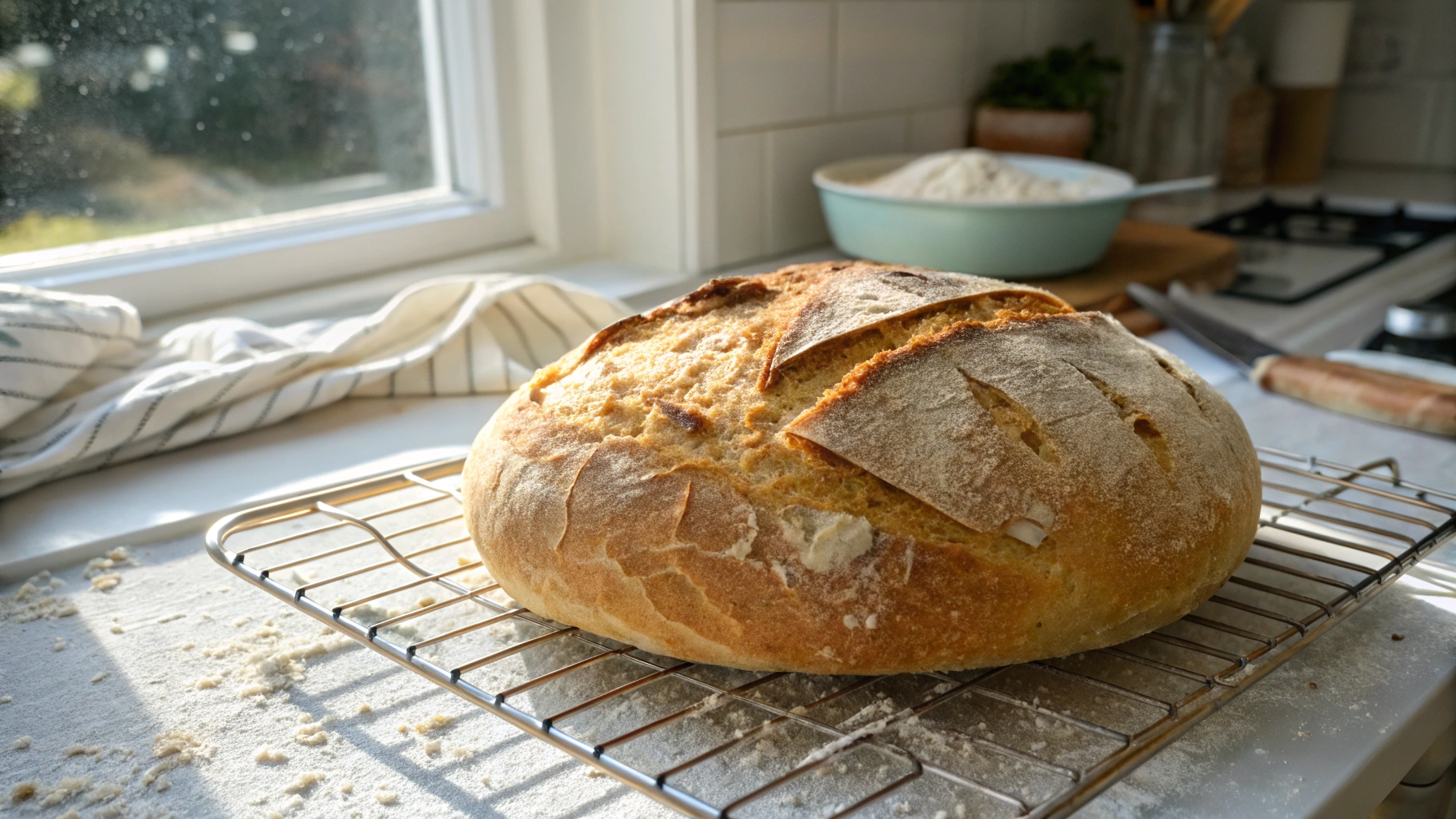Homemade Sourdough Bread Recipe
Introduction
There’s something magical about the smell of freshly baked sourdough bread filling your kitchen. The crust crackles as it cools, while the tangy aroma invites you to tear off a warm piece and slather it with butter.
Why choose this Homemade Sourdough Bread Recipe recipe?
My love for sourdough began during a quiet weekend at home when I finally tackled my fear of starters and fermentation. What seemed intimidating at first turned into one of the most rewarding baking experiences I’ve ever had—and now, sourdough has a permanent place in my weekly routine.
Ingredients for Homemade Sourdough Bread Recipe
- Flour:
- 200g bread flour
- 100g whole wheat flour
- Water: 300ml lukewarm
- Salt: 1 tsp fine sea salt or kosher salt
- Sourdough starter: 100g active starter
Preparation Steps for Homemade Sourdough Bread Recipe

Step 1: Mixing the Dough
Start by combining the sourdough starter, water, bread flour, and whole wheat flour in a large bowl. Use your hands or a wooden spoon to bring it into a shaggy dough. Let it rest for 30 minutes to fully hydrate the flour in a process called autolyse.
Step 2: Adding Salt and Fermentation
After the rest, sprinkle in the salt and mix thoroughly using a pinching and folding motion. Allow the dough to ferment at room temperature for several hours, performing gentle stretch and folds every 30–45 minutes to build gluten without kneading.
Step 3: Shaping the Dough
Once the dough has risen by about 50% and looks smooth and puffy, it’s time for shaping. Turn it out onto a lightly floured surface and shape it into a round or oval loaf. Let it rest for 20 minutes, then tighten the shape by folding and tucking the dough under itself.
Step 4: Final Proofing
Transfer the shaped dough into a well-floured proofing basket or bowl lined with a towel. Cover and let it proof at room temperature until it’s visibly puffy and holds an impression when gently pressed, typically 2–3 hours depending on ambient temperature.
Step 5: Preparing for Baking
Preheat your oven with a Dutch oven inside to 450°F (230°C). Once the dough is ready, carefully invert it onto a piece of parchment paper, slash the top with a sharp knife, and carefully transfer it into the preheated Dutch oven. Cover with the lid and bake for 20 minutes.
Step 6: Baking and Cooling
After 20 minutes, remove the lid from the Dutch oven and continue baking for another 20–30 minutes or until the crust is golden brown and the internal temperature reaches 200°F (93°C). Once baked, transfer the loaf to a wire rack to cool completely before slicing and enjoying your homemade sourdough bread.
“`html
Health Benefits of Homemade Sourdough Bread Recipe
Sourdough bread made at home offers various health benefits. Unlike commercial bread that often contains additives and preservatives, homemade sourdough is a natural and wholesome option. The fermentation process involved in making sourdough helps break down gluten and phytic acid, making it easier to digest for some individuals with gluten sensitivities. Additionally, sourdough bread has a lower glycemic index compared to regular bread, which can help in managing blood sugar levels. The presence of beneficial bacteria in sourdough also contributes to gut health and overall well-being.
Origin and History of the Homemade Sourdough Bread Recipe
The tradition of sourdough breadmaking dates back centuries, with its origins rooted in ancient Egypt. The process of fermenting dough using wild yeast and lactobacilli cultures was a common method of leavening bread before the advent of commercial yeast. Sourdough gained popularity during the California Gold Rush in the mid-19th century when miners relied on it as a staple food due to its durability and tangy flavor. Today, homemade sourdough bread continues to be a beloved culinary tradition in many households around the world.
Delicious Variations Around Homemade Sourdough Bread Recipe
While the classic sourdough bread recipe is a timeless favorite, there are countless variations to explore and experiment with. You can customize your sourdough loaves by incorporating ingredients like herbs, seeds, nuts, dried fruits, or even cheese to add unique flavors and textures. Additionally, adjusting the hydration levels or fermentation times can result in different crust textures and crumb structures. From olive and rosemary sourdough to cinnamon raisin swirl, the possibilities for creative sourdough variations are endless.
Chef’s Tips for Perfecting Your Homemade Sourdough Bread Recipe
1. Maintain a consistent feeding schedule for your sourdough starter to keep it healthy and active.
2. Use a kitchen scale to measure ingredients by weight for precision and consistency in your bread baking.
3. Experiment with different flour blends to discover flavor profiles that suit your preferences.
4. Pay attention to dough texture and fermentation cues rather than strictly following time guidelines.
5. Preheat your baking vessel before adding the dough to achieve a crisp crust.
6. Embrace imperfections in your loaves—each sourdough bread is unique and has its own character.
7. Practice patience and enjoy the process of breadmaking; it’s as much about the journey as it is about the final product.
“`to a proofing basket lined with a well-floured towel, seam side up. Cover it loosely with plastic wrap or another towel and refrigerate it overnight for a slow, cold proof. This step enhances flavor and makes scoring easier.
Mistakes to Avoid When Preparing Homemade Sourdough Bread Recipe
While making homemade sourdough bread can be a deeply rewarding experience, there are common mistakes that can lead to less-than-perfect loaves. Avoid these pitfalls to ensure your bread turns out delicious every time:
- Skipping the autolyse: Allowing the flour to fully hydrate during the autolyse stage is crucial for gluten development and a better texture.
- Overproofing: Pay attention to your dough’s rise and don’t let it go too far, as overproofing can lead to a dense loaf.
- Not maintaining the starter: A healthy and active starter is key to a successful sourdough bread. Regular feedings and attention are essential.
- Underbaking: Make sure your bread is baked through by checking internal temperature or tapping the bottom for a hollow sound.
Ingredient Alternatives for Homemade Sourdough Bread Recipe
If you’re looking to switch up your sourdough bread recipe, here are some ingredient alternatives you can experiment with:
- Flour: Try using rye flour or spelt flour for a different flavor profile.
- Water: Replace some of the water with milk for a softer crumb.
- Salt: Use sea salt infused with herbs or spices for a unique taste.
- Sourdough starter: Incorporate a different type of flour into your starter for a twist on flavor.
Tips and Tricks to Perfect Your Homemade Sourdough Bread Recipe
For bakery-quality sourdough bread at home, consider these tips and tricks to elevate your baking game:
- Experiment with different scoring patterns to create stunning designs on your loaves.
- Adjust the fermentation time based on your schedule for optimal flavor development.
- Preheat your Dutch oven before baking to ensure a crispy crust.
- Try incorporating seeds, nuts, or dried fruits into your dough for added texture and flavor.
Side Dish Suggestions for Homemade Sourdough Bread Recipe
Pair your freshly baked sourdough bread with these delicious side dishes to complete your meal:
- Roasted garlic and herb butter for a flavorful spread.
- Caprese salad with ripe tomatoes, fresh mozzarella, and basil.
- Homemade vegetable soup for a comforting and hearty accompaniment.
- Olive oil and balsamic vinegar dip with herbs and spices for dipping.
FAQ about the recipe Homemade Sourdough Bread Recipe
How to store the recipe Homemade Sourdough Bread Recipe after cooking?
To store your freshly baked Homemade Sourdough Bread, allow it to cool completely. Once cooled, wrap it in a clean, dry kitchen towel or place it in a paper bag to maintain its crusty exterior. Avoid sealing it in plastic, as this can make the crust soft. For longer storage, you can freeze the loaf by wrapping it tightly in foil or plastic wrap.
Can the recipe Homemade Sourdough Bread Recipe be prepared in advance?
Yes, you can prepare the Homemade Sourdough Bread recipe in advance by dividing the process into stages. You can mix the dough and let it ferment in the refrigerator overnight, then continue with shaping and baking the following day. This method allows for a more flexible baking schedule while still achieving a delicious, tangy loaf.
What ingredients can be substituted in the recipe Homemade Sourdough Bread Recipe?
If you need to make substitutions in the Homemade Sourdough Bread recipe, you can experiment with different types of flour based on your preferences. For example, you can use rye flour, spelt flour, or even gluten-free flour blends. Additionally, you can add seeds, nuts, or dried fruits for extra flavor and texture.
How to adapt the recipe Homemade Sourdough Bread Recipe for a vegetarian version?
To adapt the Homemade Sourdough Bread recipe for a vegetarian version, simply ensure that all ingredients used are plant-based. Double-check that the flour, water, salt, and sourdough starter are all vegetarian-friendly. Avoid any animal-derived additives or enhancers in the ingredients to maintain the vegetarian status of the bread.
Is the recipe Homemade Sourdough Bread Recipe suitable for children?
Homemade Sourdough Bread can be a nutritious and delicious option for children. The natural fermentation process of sourdough makes it easier to digest compared to regular bread, and the absence of commercial yeast can be beneficial for sensitive tummies. You can also customize the toppings or mix-ins to cater to your child’s taste preferences, making it a versatile and kid-friendly snack or meal option.
Conclusion about the recipe Homemade Sourdough Bread Recipe
Bringing the aroma and taste of a bakery into your home, this Homemade Sourdough Bread recipe is a delightful journey of flavors and textures. From the initial mix of ingredients to the final golden crust, each step is a testament to the art of traditional breadmaking. Whether you’re a seasoned baker or a novice in the kitchen, this recipe offers a rewarding experience that fills your home with warmth and the unmistakable scent of freshly baked bread.
📌 Keep This Recipe Handy & Discover More Tasty Ideas!
Enjoyed this recipe? Don’t let it slip away! Save it now on Pinterest so it’s always just a click away. Pinning it also helps others find simple, delicious meal ideas!
💡 Whether you’re organizing your weekly meal plan or whipping up something special for guests, having your go-to recipes saved makes life in the kitchen so much easier. Use Pinterest to collect your favorites, explore new versions of classic dishes, and revisit your top meals anytime.
📲 Don’t forget to follow us on Pinterest for a daily dose of inspiration — from cozy family dinners and quick lunches to seasonal desserts and healthy snacks. We update regularly with recipes designed to fit your lifestyle and taste.
📖 Craving more? Head over to our full recipe library to browse a wide variety of easy and flavorful dishes. No matter your skill level, you’ll find recipes that are simple to make and packed with flavor.
✨ Bookmark your favorites and swing by often — there’s always something fresh and delicious waiting for you!





